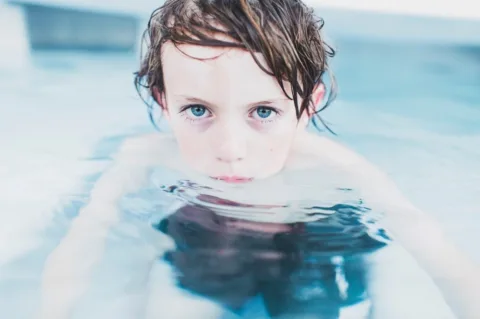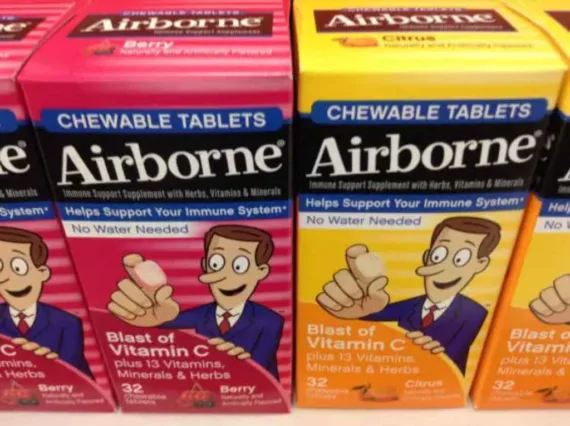Summer is here and more children are playing in the water. As exciting as that sounds, summer unfortunately presents some risks to everyone who enjoys the water — especially children.
There are 2 hidden dangers — secondary drowning and dry drowning — that are causing parents to be hyper-vigilant, not only when their kids are in the water but even after they get out of the water.
Dry drowning and secondary drowning usually occur hours after getting out of the water.
Have you witnessed kids swimming and heard them coughing up a lot of water after swallowing it in the pool?
I have. I’ve also seen children nearly drown during my many years as a lifeguard. Therefore, I’m passionate about teaching kids how to swim. I taught swim lessons on and off for over 18 years.
Both of my children were taught how to swim when they were toddlers. The safe start kids swimming program is a really great way to teach toddlers to survival swim.
During these swim lessons, my son used to swallow so much water! He never acted differently after the lessons, but I learned that monitoring children after they swallow water is very important.
Dry drowning isn’t new — we’re just starting to hear more about it these days. We’re beginning to hear of more and more cases of children suffering from secondary drowning as well.
Here’s what you need to know about dry drowning and secondary drowning — and how to prevent it from happening in the first place.
What Is Dry Drowning?
Dry drowning sounds like something out of a Hollywood movie, but it’s a very real thing. It’s called dry drowning because no fluid enters the lungs.
In a normal drowning, a swimmer will aspirate a lot of water into their lungs as they struggle in the water. In dry drowning, the larynx goes shut as a protective response. No water gets in, but no air gets in either. It’s called a laryngospasm — a constriction of muscles in the airway. The longer it takes for the larynx to relax, the longer the body is deprived of oxygen. Being deprived of oxygen for even a few minutes is fatal. Kids with heart defects and respiratory difficulties like asthma are at particular risk. Source
Here’s what happens to a dry drowning victim:
- The muscles of the larynx or voice box spasm as fluid passes over the vocal chords, causing the airway to close up. This prevents fluid from entering the lungs, but also makes it difficult to breathe.
- It occurs immediately after fluid enters the airway via mouth or nose. If you’ve ever had your drink “go down wrong” and felt that gasping, coughing reaction — then you know a little bit of what dry drowning is.
Here are signs and symptoms of dry drowning:
- Coughing
- Sleepiness
- Feeling nauseous
- Memory loss
- Difficulty breathing
- Behavioral changes
Depending on the severity of a dry drowning episode, a trip to the emergency room may be required.
Any time you’re concerned about your child and think he could have symptoms of dry drowning, whether you’re in your backyard pool or on a beach vacation, call the pediatrician right away for advice. Your child’s doctor should be able to talk you through it and might advise you to go to the ER, a primary care doctor, or a national urgent care center. But if your child is really struggling to breathe, call 911 and/or head to the emergency room right away. Necessary treatment may not be available in settings other than the ER. Source
Treatment for dry drowning symptoms typically involves:
- Getting a chest x-ray
- Having an IV
- Being monitored for signs of respiratory distress or compromise
What Is Secondary Drowning?
Secondary drowning can occur anywhere from 1 hour to 24 hours after the fluid is inhaled. Fluid actually enters the lungs.
Secondary drowning occurs when water is aspirated into the lungs and collects there as a person struggles in the water. That collection of fluid in the lungs is called pulmonary edema, which causes difficult or rapid breathing that can make a “crackle” sound. Within an hour, you will start seeing those respiratory difficulties. Secondary drowning can be severe enough that a child can end up on a ventilator. Source
Here’s what happens do a secondary drowning victim:
- Fluid enters the lungs (unlike dry drowning).
- The body tries to neutralize it by producing more fluid.
- Within about 1 hour, this will cause difficulty breathing.
Here are the signs and symptoms of secondary drowning:
- Difficulty breathing
- Extreme tiredness or lethargy
- Nausea and vomiting
- Behavioral changes
- Blue tint around the lips and nail beds
If secondary drowning symptoms are suspected, a trip to the emergency room is definitely required!
Going to the hospital promptly is your best defence. Doctors will closely monitor your child and, when caught early, should be able to treat any issues by administering oxygen and removing fluids through diuretics. Ignoring the symptoms or waiting too long to seek treatment is, tragically, when secondary drowning can turn fatal. If a near drowning has occurred and your child is showing any of these symptoms, don’t delay in getting them checked out. Source
Treatment for secondary drowning symptoms typically includes:
- Administering oxygen
- Removing fluids through diuretics
- Taking antibiotics — since infection is a big risk (Moist places are a haven for bacteria growth.)
Here’s some great information on the 3 types of drowning: wet drowning, dry drowning, and secondary drowning.
How To Prevent Dry Drowning & Secondary Drowning
It’s best to be proactive before you take your kids swimming. You should learn all there is to know about water safety. And make sure your children learn how to swim.
My daughter and son both learned survival swimming skills before they were talking in full sentences! Since more and more cases of secondary drowning are appearing on the news, I want to share some water safety tips on dry drowning prevention.
Here are some simple ways to prevent these 2 types of drowning:
- Enroll your kids in swimming lessons. Kids who are comfortable and skilled at moving around in the water are less likely to go under and take in water. Around 6 months is the youngest age to start babies in swim lessons. Around age 4 is also a good time to start kids swimming lessons
- Monitor kids closely in and around the water. Enforce pool safety rules.
- Adhere to water safety measures. For example, children who know how to swim should wear smaller life jackets
on boats. And swimming pools should have 4-sided fencing around them.
For teenagers and young adults, make sure they understand that drugs, alcohol, and playing in or near water don’t mix. It’s the same for adults as well.
These types of drownings aren’t that common, generally representing only 1% to 2% of all drownings. However, it’s still a good idea to know what to watch for — just in case.
Check out this story that appeared on The Today Show as a warning for other parents about secondary drowning.
The Bottom Line
Don’t assume that just because your fun time in the water has ended for the day, you don’t need to be aware of possible drowning symptoms. While dry drowning and secondary drowning are most common with children, anyone could be at risk — for a full day after being in the water!
Try not to get overly anxious about it though — to the point you’re unable to enjoy swimming outings with your family. I found this article about how rare secondary drowning is comforting.
Enjoy your summer and have fun taking your kids to the pool, beach, or lake. Knowing that you’ve done your part in preventing a secondary drowning episode by ensuring your kids know how to swim will ease your mind!
Here’s some great information about the 3 types of drowning: wet drowning, dry drowning, and secondary drowning.
I’m a health nut, a frugal mom, a dog lover, a DIYer, and a gadget girl. Personally, as a post-divorce, working single mom on a budget I have a lot of experiences that I enjoy sharing so others can learn from the things I wish I knew earlier! Professionally, I’ve worked full-time in a variety of marketing, sales, and editing jobs. You can always find me at the corner of Good News & Fun Times as Managing Editor at The Fun Times Guide (32 fun & helpful websites).





